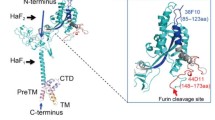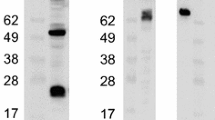Abstract
Complementary DNA fragments (nucleotides 935–1475, 1091–1310, and 935–1193) encoding the N-terminal portion of glycoprotein E of West Nile virus (WNV), strain LEIV-Vlg99-27889-human, were cloned. Recombinant polypeptides of glycoprotein E (E1–180, E53–126, and E1–86) of the WNV having amino acid sequences corresponding to the cloned cDNA fragments and mimicking the main functional regions of domains I and II of surface glycoprotein E were purified by affinity chromatography. According to ELISA and Western blotting, 12 types of monoclonal antibodies (MAbs) raised in our laboratory against recombinant polypeptide E1–180 recognized the WNV glycoprotein E. This is indicative of similarity between the antigenic structures of the short recombinant polypeptides and corresponding regions of the glycoprotein. Analysis of interactions of the MAbs with short recombinant polypeptides and protein E of tick-borne encephalitis virus revealed at least six epitopes within domains I and II of the WNV protein E. We found at least seven MAb types against the region between amino acid residues (aa) 86 and 126 of domain II, which contains the peptide responsible for fusion of the virus and cell membranes (residues 98–110). The epitope for antireceptor MAbs 10H10 was mapped within the 53–86 aa region of domain II of WNV protein E, which is evidence for the spatial proximity of the fusion peptide and the coreceptor of protein E (residues 53–86) for cellular laminin-binding protein (LBP). The X-ray pattern of protein E suggests that the bc loop (residues 73–89) of domain II interacts with LBP and, together with the cd loop (fusion peptide), determines the initial stages of flavivirus penetration into the cell.
Similar content being viewed by others
REFERENCES
Calisher C.H., Karabatsos N. 1988. In: Arbovirus Serogroups: Definition and Geographic Distribution. Ed. Monath T.P. London: CRC Press, pp. 19–57.
Lindenbach B.D., Rice C.M. 2001. Flaviviridae: The viruses and their replication. In: Fundamental Virology, 4th ed. Eds. Knippe D.M., Howley P.M. Philadelphia: Lippincott Williams & Wilkins, pp. 589–641.
Calisher C.H., Karabatsos N., Dalrymple J.M., Shope R.E., Porterfield J.S., Westaway E.G., Brandt W.E. 1989. Antigenic relationships between flaviviruses as determined by cross-neutralization tests with polyclonal antisera. J. Gen. Virol. 70, 37–43.
Campbell G.L., Marfin A.A., Lanciotti R.S., Gubler D.J. 2002. West Nile virus. Lancet. Infect. Dis. 9, 519–529.
Nash D., Mostashari F., Fine A., Miller J., O'Leary D., Murray K., Huang A., Rosenberg A., Greenberg A., Sherman M., Wong S., Layton M. 2001. Outbreak of West Nile virus infection, New York City area, 1999. N. Engl. J. Med. 344, 1807–1814.
Hanna J.N., Ritchie S.A., Phillips D.A., Shield J., Bailey M.C., Mackenzie J.S., Poidinger M., McCall B.J., Mills P.J. 1996. Experience with WN virus in the Old World and SLE. An outbreak of Japanese encephalitis in the Torres Strait, Australia, 1995. Med. J. 165, 256–260.
Lanciotti R.S., Roehrig J.T., Deubel V., Smith J., Parker M., Steele K., Crise B., Volpe K.E., Crabtree M.B., Scherret J.H., Hall R.A., MacKenzie J.S., Cropp C.B., Panigrahy B., Ostlund E., Schmitt B., Malkinson M., Banet C., Weissman J., Komar N., Savage H.M., Stone W., McNamara T., Gubler D.J. 1999. Origin of the West Nile virus responsible for an outbreak of encephalitis in the northeastern United States. Science. 286, 2333–2337.
http://www.cdc.gov/od/oc/media/wnv/cases.htm
Lvov D.K., Butenko A.M., Gromashevsky V.L., Larichev V.P., Gaidamovich S.Y., Vyshemirsky O.I., Zhukov A.N., Lazorenko V.V., Salko V.N., Kovtunov A.I., Galimzyanov K.M., Platonov A.E., Morozova T.N., Khutoretskaya N.V., Shishkina E.O., Skvortsova T.M. 2000. Isolation of two strains of West Nile virus during an outbreak in southern Russia, 1999. Emerg. Infect. Dis. 6, 373–376.
Lvov D.K., Butenko A.M., Gromashevsky V.L., Kovtunov A.I., Prilipov A.G., Kinney R., Aristova V.A., Dzharkenov A.F., Samokhvalov E.I., Savage H.M., Shchelkanov M.Y., Galkina I.V., Deryabin P.G., Gubler D.J., Kulikova L.N., Alkhovsky S.K., Moskvina T.M., Zlobina L.V., Sadykova G.K., Shatalov A.G., Lvov D.N., Usachev V.E., Voronina A.G. 2004. West Nile virus and other zoonotic viruses in Russia: Examples of emerging-reemerging situations. Arch. Virol. Suppl. 18, 85–96.
Lanciotti R.S., Ebel G.D., Deubel V., Kerst A.J., Murri S., Meyer R., Bowen M., McKinney N., Morrill W.E., Crabtree M.B., Kramer L.D., Roehrig J.T. 2002. Complete genome sequences and phylogenetic analysis of West Nile virus strains isolated from the United States, Europe, and the Middle East. Virology. 298, 96–105.
Rey F.A., Heinz F.X., Mandl C., Kunz C., Harrison S.C. 1995. The envelope glycoprotein from tick-borne encephalitis virus at 2 Å resolution. Nature. 375, 291–298.
Pytela R., Pierschbacher M.D. 1987. Arginine-glycine-aspartic acid adhesion receptors. Methods Enzymol. 144, 475–489.
Allison S.L., Schalich J., Stiasny K., Mandl C.W., Heinz F.X. 2001. Mutational evidence for an internal fusion peptide in flavivirus envelope protein E. J. Virol. 75, 4268–4275.
Roehrig J.T., Hunt A.R., Johnson A.J., Hawkes R.A. 1989. Synthetic peptides derived from the deduced amino acid sequence of the E glycoprotein of Murray Valley encephalitis virus elicit antiviral antibody. Virology. 171, 49–60.
Roehrig J.T., Johnson A.J., Hunt A.R., Bolin R.A., Chu M.C. 1990. Antibodies to Dengue 2 virus E-glycoprotein synthetic peptides identify antigenic conformation. Virology. 177, 668–675.
Allison S.L., Schalich J., Stiasny K., Mandl C.W., Kunz C., Heinz F.X. 1995. Oligomeric rearrangement of tick-borne encephalitis virus envelope proteins induced by an acidic pH. J. Virol. 69, 695–700.
Stiasny K., Allison S.L., Marchler-Bauer A., Kunz C., Heinz F.X. 1996. Structural requirements for low-pH-induced rearrangements in the envelope glycoprotein of tick-borne encephalitis virus. J. Virol. 70, 8142–8147.
Modis Y., Ogata S., Clements D., Harrison S.C. 2004. Structure of the Dengue virus envelope protein after membrane fusion. Nature. 427, 313–320.
Protopopova E.V., Khusainova A.D., Konovalova S.N., Loktev V.B. 1996. Production and characterization of anti-idiotype antibodies carrying hemagglutinating paratopes of tick-borne encephalitis virus on their surface. Vopr. Virusol. 2, 50–53.
Protopopova E.V., Sorokin A.V., Konovalova S.N., Kachko A.V., Netesov S.V., Loktev V.B. 1999. Human laminin binding protein as a cell receptor for tick-borne encephalitis virus. Zbl. Bacteriol. 289, 632–638.
Thepparit C., Smith D.R. 2004. Serotype-specific entry of Dengue virus into liver cells: identification of the 37-kilodalton/67-kilodalton high-affinity laminin receptor as a Dengue virus serotype 1 receptor. J. Virol. 78, 12647–12656.
Loktev A.V., Kuvshinov V.N., Medlamed N.V., Ivanisenko V.A., Mishin V.P., Il'ichev A.A. 2002. Localization of the tick-borne encephalitis virus protein E antigenic determinant recognized by antihemagglutinating monoclonal antibodies using a peptide phage library. Vopr. Virusol. 47, 31–34.
Lvov D.K., Butenko A.M., Gromashevsky V.L., Larichev V.P., Gaidamovich S.Y., Vyshemirsky O.I., Zhukov A.N., Lazorenko V.V., Salko V.N., Kovtunov A.I., Galimzyanov K.M., Platonov A.E., Morozova T.N., Khutoretskaya N.V., Shishkina E.O., Skvortsova T.M. 2000. Isolation of two strains of West Nile virus during an outbreak in Southern Russia, 1999. Emerg. Infect. Dis. 6, 373–376.
Gaidamovich S.Ya., Loktev V.B., Lavrova N.A. Cross reactivity between tick-borne encephalitis and Venezuelan equine encephalomyelitis viruses as revealed by monoclonal antibodies. Vopr. Virusol. 3, 221–225.
Ternovoi V.A., Shchelkanov M.Yu., Shestopalov A.M., Aristova V.A., Protopopova E.V., Gromashevsky V.L., Druzyaka A.V., Zolotykh S.I., Loktev V.B., Lvov D.K. 2004. West Nile virus revealed in birds in the Kulunda and Baraba lowlands (West Siberian flyway) in the summer-autumn period of 2002. Vopr. Virusol. 49, 52–56.
Gefter M.L., Margulies D.H., Scharft M.D. 1977. A simple method for polyethylene glycol-promoted hybridization of mouse myeloma cells. Somat. Cell. Genet. 3, 231–236.
Razumov I.A., Agapov E.V., Pereboev A.V., Protopopova E.V., Lebedeva S.D., Loktev V.B. 1991. Antigenic structure of the Venezuelan equine encephalomyelitis E2 glycoprotein as analyzed with rat monoclonal antibodies. Vopr. Virusol. 36, 34–37.
Laemmli U.K. 1970. Cleavage of structural proteins dur-ing the assembly of the head of bacteriophage T4. Nature. 227, 680–685.
Towbin H.T., Staehelin J.G. 1979. Electrophoretic transfer of proteins from polyacrylamide gels to nitrocellulose sheets: Procedure and some applications. Proc. Natl. Acad. Sci. USA. 76, 4350–4354.
Towbin H., Gordon J. 1984. Immunoblotting and dot immunobinding: Current status and outlook. J. Immunol. Meth. 72, 313–340.
Shindyalov I.N., Bourne P.E. 1998. Protein structure alignment by incremental combinatorial extension (CE) of the optimal path. Protein Eng. 11, 739–747.
Chambers T.J., Hanh C.S., Galler R., Rice C. M. 1990. Flavivirus genome organization, expression, and replication. Rev. Microbiol. 44, 649–688.
Heinz F.X., Roehrig J.T. 1990. Immunochemistry of viruses. The basis for serodiagnosis and vaccines. 2, 289–305.
Pletnev S.V., Zhang W., Mukhopadhyay S., Fisher B.R., Hernandez R., Brown D.T., Baker T.S., Rossmann M.G., Kuhn R.J. 2001. Locations of carbohydrate sites on alphavirus glycoproteins show that E1 forms an icosahedral scaffold. Cell. 105, 127–136.
Kenneth R.G., McCairn T.J., Behtol K.B. 1983. Monoclonal antibodies. In: Gibridomy: novyi uroven' biologicheskogo analiza (Hybridomas: A New Level of Biological Analysis). Moscow: Meditsina.
Rudzevich T.N., Ternovoi V.A., Kazachinskaya E.I., Razumov I.A., Chepurnov A.A., Loktev V.B., Netesov S.V. 2003. Revealing antigenic determinants at the N-terminus of the Ebola virus VP35 protein using short recombinant fragments of this protein. Mol. Genet. Mikrobiol. Virusol. 2, 38–40.
Sorokin A.V., Kazachinskaia E.I., Ivanova A.V., Kachko A.V., Netesov S.V., Bukreyev A.A., Loktev V.B., Razumov I.A. 2002. Mapping of two dominant sites of VP35 of Marburg virus. Viral Immunol. 15, 481–493.
Cheshenko N.V., Petrov V.S., Protopopova E.V., Netesova N.A., Konovalova S.N., Belavin P.A., Loktev V.B., Malygin E.G. 1997. Recombinant vaccine virus expressing the Japanese encephalitis virus E protein. Mol. Genet. Mikrobiol. Virusol. 3, 24–27.
Belavin P.A. Netesova N.A., Reshetnikov S.S., Ivanisenko V.A., Eroshkin A.M., Protopopova E.V., Loktev V.B., Malygin E.G. 1997. Expression of Japanese encephalitis virus E gene fragments in Escherichia coli cells. Biotekhnologiya. 3, 3–9.
Butrapet S., Kimura-Kuroda J., Zhou D.-Sh., Yasui K. 1998. Neutralizing mechanism of a monoclonal antibody against Japanese encephalitis virus glycoprotein E. Am. J. Trop. Med. Hyg. 58, 389–398.
Beasley D.W.C., Barrett A.D.T. 2002. Identification of neutralizing epitopes within structural domain III of the West Nile virus envelope protein. J. Virol. 76, 13097–13100.
Author information
Authors and Affiliations
Additional information
__________
Translated from Molekulyarnaya Biologiya, Vol. 39, No. 5, 2005, pp. 813–822.
Original Russian Text Copyright © 2005 by Bogachek, Protopopova, Ternovoi, Kachko, Ivanova, Ivanisenko, Loktev.
Rights and permissions
About this article
Cite this article
Bogachek, M.V., Protopopova, E.V., Ternovoi, V.A. et al. Immunochemical Properties of Recombinant Polypeptides Mimicking Domains I and II of West Nile Virus Glycoprotein E. Mol Biol 39, 710–718 (2005). https://doi.org/10.1007/s11008-005-0086-9
Received:
Issue Date:
DOI: https://doi.org/10.1007/s11008-005-0086-9




